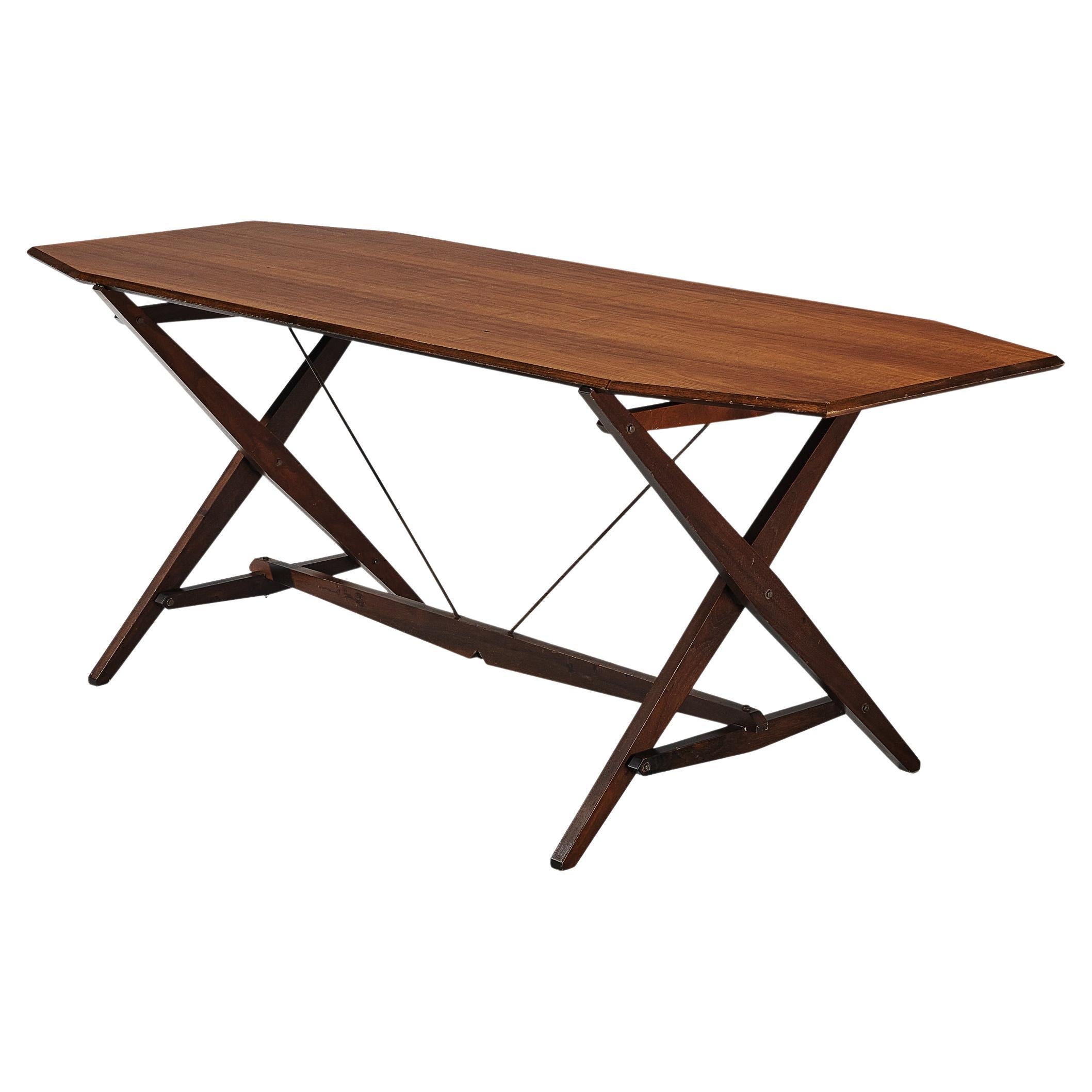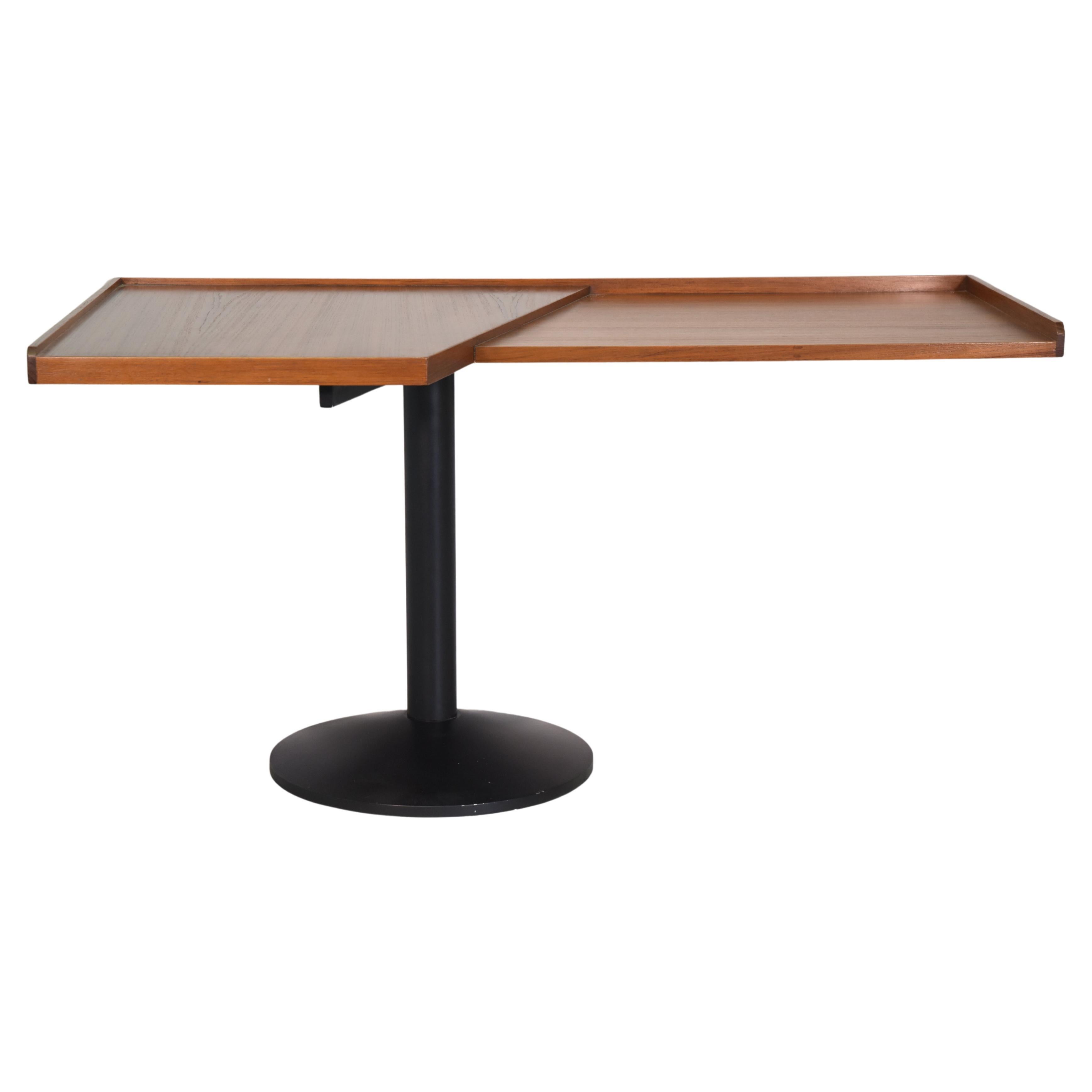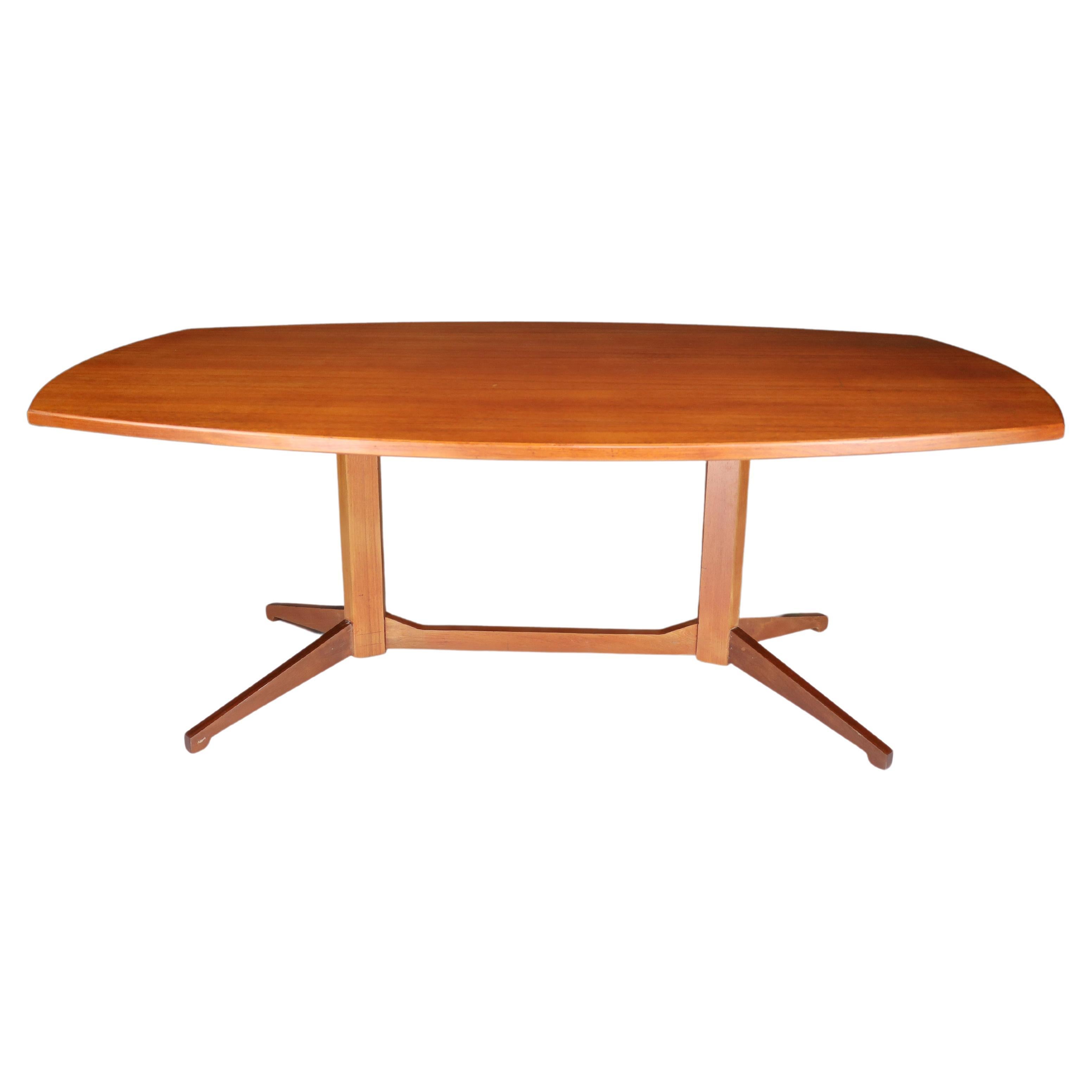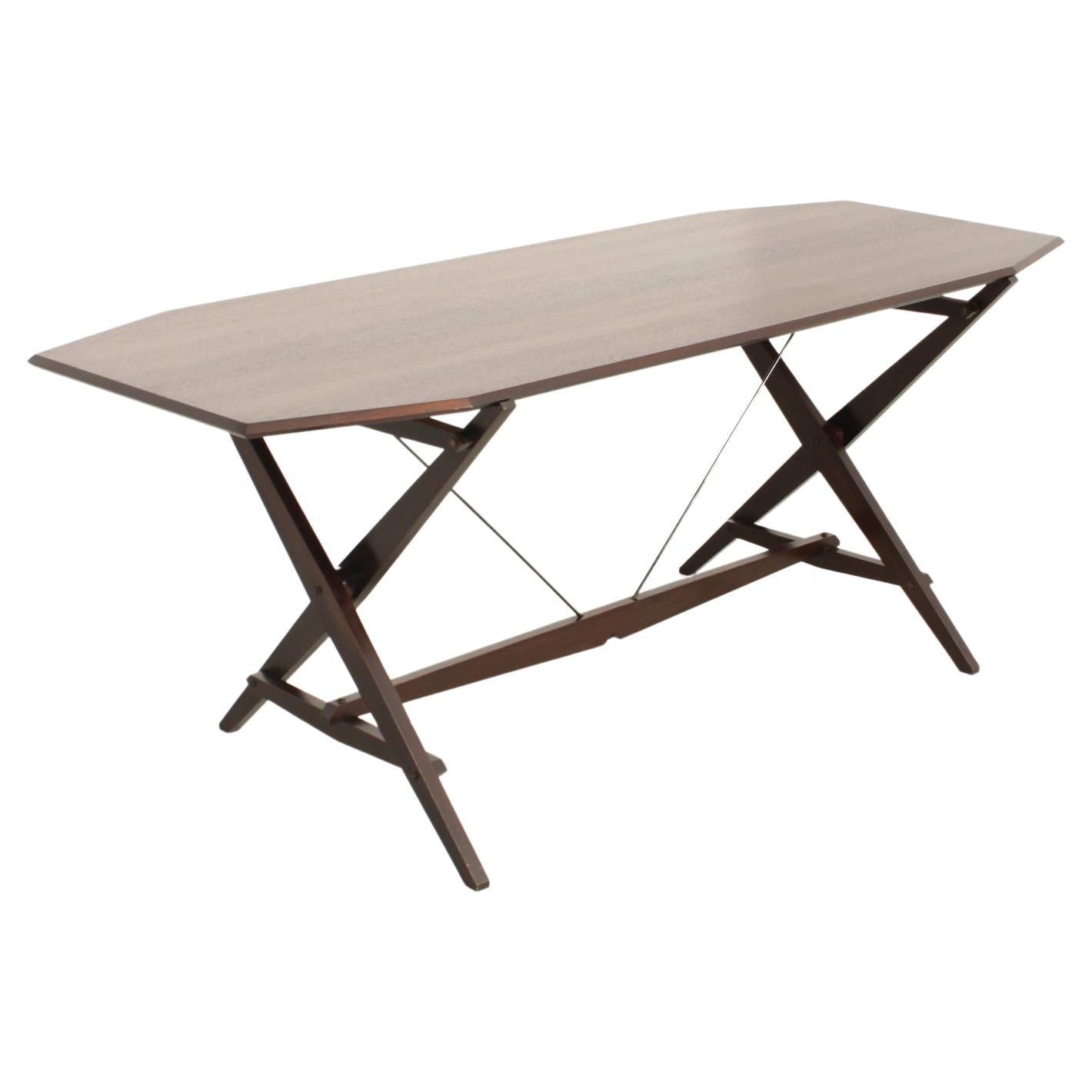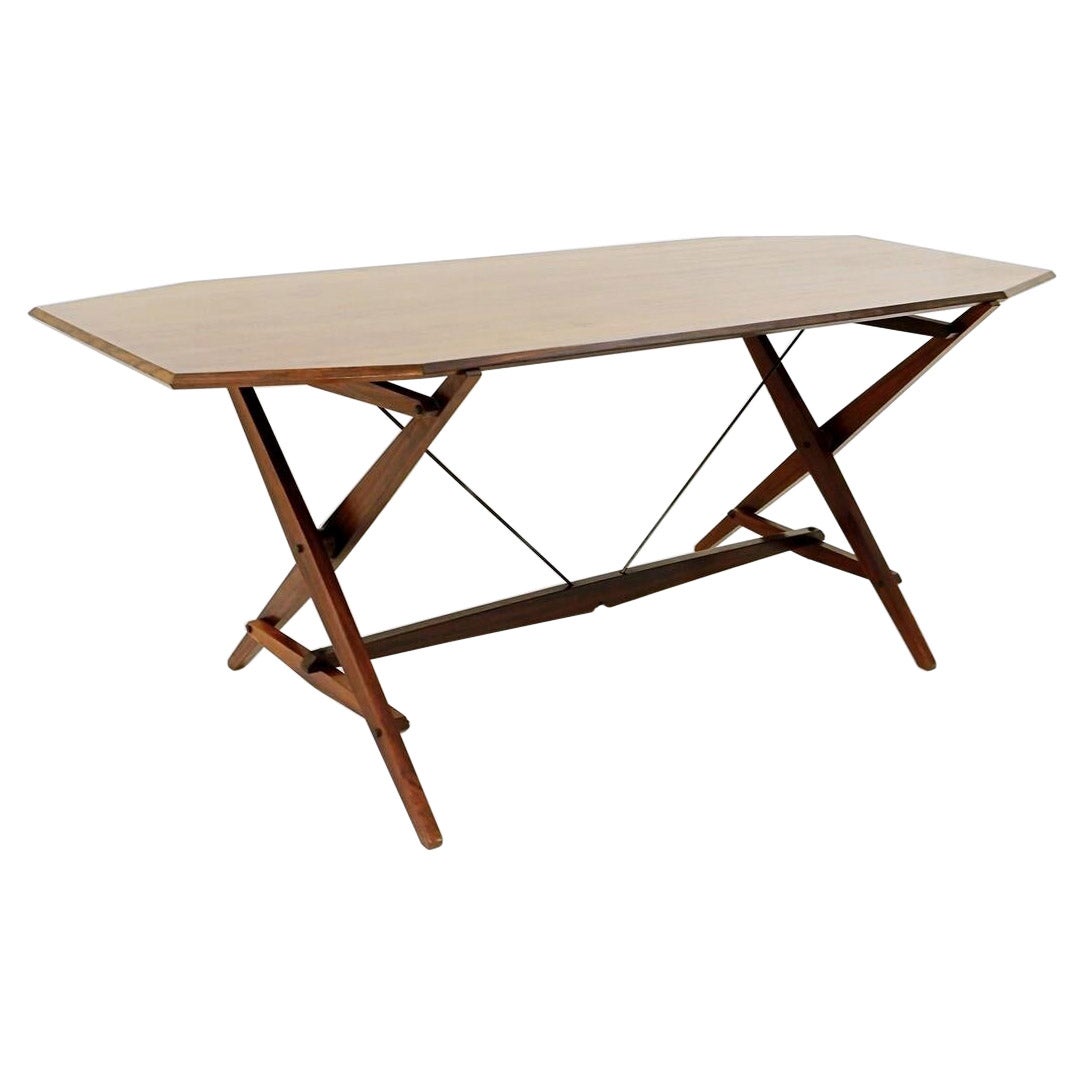Franco Albini Rosewood Mid-Century Modern “LB7” Modular Bookcase for Poggi, 1957
About the Item
- Creator:Poggi (Manufacturer),Franco Albini (Designer)
- Design:
- Dimensions:Height: 109.45 in (278 cm)Width: 104.34 in (265 cm)Depth: 13.78 in (35 cm)
- Style:Mid-Century Modern (Of the Period)
- Materials and Techniques:
- Place of Origin:
- Period:
- Date of Manufacture:1957
- Condition:Minor fading.
- Seller Location:Vicenza, IT
- Reference Number:1stDibs: LU8019232897372
Franco Albini
While working under the polymath Gio Ponti — arguably the most important figure in 20th-century Italian modernism — furniture designer Franco Albini nurtured a love for modern forms combined with traditional craft techniques.
Albini is widely known for working with organic materials such as rattan and cane for his chairs and other seating, but he also played a pivotal role in the Italian rationalist movement of the early 20th century, which saw architects and furniture makers applying a strict emphasis on geometry in their work. Rationalists drew on Ancient Roman architecture but rejected ornament, much in the way that Le Corbusier and celebrated Bauhaus figures such as Ludwig Mies van der Rohe had in their modernist furniture.
Albini received his degree in architecture from the Polytechnic University of Milan in 1929, and, in 1931, he founded his practice in Milan, where he tackled workers’ housing and other reconstruction projects. A gifted urban planner, he also developed the Palazzo Bianco, Palazzo Rosso and Tesoro di San Lorenzo museums in Genoa. While Albini is revered for his Margherita chair — a Triennale Milano award winner created for Bonacina in 1951 — he also collaborated with manufacturers Poggi and Cassina in the 1940s on seating, tables and more that embodied his artistic vision. Of that mid-century work, the one piece that perhaps best captures this vision is the iconic Luisa chair.
With its cherry red upholstery and sinuous wooden legs that seem to float aboveground, the Luisa is a genuine masterpiece. It is also a testament to Albini’s perfectionism, as it endured several prototypes — including one made by Knoll in the late 1940s — and took approximately 15 years to design. Poggi launched the final version of the armchair in 1955, earning Albini the prestigious Compasso d’Oro from Italy’s Association for Industrial Design. It is produced today by Cassina. Albini named the chair for someone who likely saw the process firsthand: his personal secretary of two decades, Luisa Colombini.
Find vintage Franco Albini furniture on 1stDibs.
- ShippingRetrieving quote...Ships From: Vicenza, Italy
- Return PolicyA return for this item may be initiated within 14 days of delivery.
- Carlo Scarpa Mid-Century Brown Walnut “Scuderia” Dining Table for Bernini, 1977By Bernini, Carlo ScarpaLocated in Vicenza, IT“Scuderia” dining table, designed by Carlo Scarpa and produced by the Italian manufacturer Bernini in 1977. Originally, Carlo Scarpa designed the table to restore the stable of Villa Valmarana in Vicenza in 1972. The table features a solid walnut structure. Available also five “Kentucky” dining...Category
Vintage 1970s Italian Mid-Century Modern Dining Room Tables
MaterialsWalnut
- Vittorio Nobili Mid-Century Teak Medea Dining Room Set with Table & Chairs, 1956By Vittorio NobiliLocated in Vicenza, ITSet composed of four Medea dining chairs and their circular table, designed by Vittorio Nobili for Fratelli Tagliabue in 1954. Made of teak plywood, excellent vintage condition. Reported at “Compasso d’Oro Prize at Milano Triennale, in 1956. The Medea chair was manufactured in Italy between 1950 to 1959. The manufacturer of this chair was Fratelli Tagliabue. Vittorio Nobili designed it. Although he designed this chair in vintage times, it is suitable for our modern needs. This chair adds elegance and looks to its surroundings. This chair was reported at the prestigious Industrial Design Award, Compasso d’Oro, in 1955. Other iconic pieces, such as Soriana by Afra and Tobia Scarpa...Category
Vintage 1950s Italian Mid-Century Modern Dining Room Chairs
MaterialsIron
- Carlo Scarpa Walnut and Leather "Scuderia" Dining Room Set for Bernini, 1977By Bernini, Carlo ScarpaLocated in Vicenza, ITScuderia dining room set, designed by Carlo Scarpa for the Italian manufacturer Bernini in 1977. Composed of 5 mod. 783 “Kentucky” dining chairs...Category
Vintage 1970s Italian Mid-Century Modern Dining Room Tables
MaterialsLeather, Plastic, Walnut
- Carlo Scarpa Cognac Leather “Kentucky” Dining Chair for Bernini, 1977, Set of 5By Bernini, Carlo ScarpaLocated in Vicenza, ITSet of 5 mod. 783 “Kentucky” dining chairs, designed by Carlo Scarpa for the Italian manufacturer Bernini in 1977. Structure made from oak and walnut timber. Seats and backrest made from cognac leather. Excellent vintage condition. Carlo Scarpa designed this chair for the “Scuderia” series., the last project he made for Bernini. The architect took inspiration from the “shaker” movement. He designed the chair slightly inclined at the front. This feature allows you to swing backward (until you lean on a wall) and remain in balance. Born in Venice on June 2nd, 1906, Carlo Scarpa began working at a very early age. A year after he had first qualified as an architect in 1926, he began working for the Murano glassmakers Cappellin & Co. in a consultative capacity. From 1927, Carlo Scarpa began to experiment with the Murano glass, and this research not only gave him excellent results here but would also inform his progress for many years to come. Between 1935 and 1937, as he entered his thirties, Carlo Scarpa accepted his first important commission, the renovation of Venice’s Cà Foscari. He adapted the spaces of this stately University building that stands on the Grand Canal banks, creating rooms for the Dean’s offices and a new hall for academic ceremonies; Mario Sironi and Mario De Luigi were charged with doing the restoration work on the frescos. After 1945, Carlo Scarpa found himself constantly busy with new commissions, including various furnishings and designs for the renovation of Venice’s Hotel Bauer and designing a tall building in Padua and a residential area in Feltre, all worth mentioning. One of his key works, despite its relatively modest diminished proportions, was the [bookshop known as the] Padiglione del Libro, which stands in Venice’s Giardini di Castello and clearly shows Scarpa’s passion for the works of Frank Lloyd Wright. In the years which were to follow, after he had met the American architect, Scarpa repeated similar experiments on other occasions, as can be seen, in particular, in the sketches he drew up in 1953 for villa Zoppas in Conegliano, which show some of his most promising work. However, this work unfortunately never came to fruition. Carlo Scarpa later created three museum layouts to prove pivotal in terms of how twentieth-century museums were set up from then on. Between 1955 and 1957, he completed extension work on Treviso’s Gipsoteca Canoviana [the museum that houses Canova’s sculptures] in Possagno, taking a similar experimental approach to the one he used for the Venezuelan Pavilion at [Venice’s] Giardini di Castello which he was building at the same time (1954-56). In Possagno Carlo Scarpa was to create one of his most significant ever works, which inevitably bears comparison with two other museum layouts that he was working on over the same period, those of: – Galleria Nazionale di Sicilia, housed in the Palazzo Abatellis in Palermo (1953-55) – Castelvecchio in Verona (1957- 1974), all of which were highly acclaimed, adding to his growing fame. Two other buildings, which are beautifully arranged in spatial terms, can be added to this long list of key works that were started and, in some cases, even completed during the nineteen fifties. After winning the Olivetti award for architecture in 1956, Scarpa began work in Venice’s Piazza San Marco on an area destined to house products made by the Industrial manufacturers Ivrea. Over the same period (1959-1963), he also worked on the renovation and restoration of the gardens and ground floor of the Fondazione Querini Stampalia in Venice, which many consider one of his greatest works. While he busied himself working on-site at the Fondazione Querini Stampalia, Carlo Scarpa also began work building a villa in Udine for the Veritti family. To shed some light on the extent to which his work evolved over the years, it may perhaps be useful to compare this work with that of his very last building, villa Ottolenghi Bardolino, which was near to completion at the time of his sudden death in 1978. Upon completion of villa Veritti over the next ten years, without ever letting up on his work on renovation and layouts, Scarpa accepted some highly challenging commissions, working on the Carlo Felice Theatre in Genoa and another theatre in Vicenza. Towards the end of this decade, in 1969, Rina Brion commissioned Carlo Scarpa to build the Brion Mausoleum in San Vito d’Altivole (Treviso), a piece he continued to work on right up until the moment of his death. Nevertheless, even though he was totally absorbed by work on this mausoleum, there are plenty of other episodes which can offer some insight into the final years of his career. As work on the San Vito d’Altivole Mausoleum began to lessen from 1973, Carlo Scarpa started building the new headquarters for the Banca Popolare di Verona. He drew up plans that were surprisingly different from the work he was carrying out at the same time on the villa Ottolenghi. However, the plans Carlo Scarpa drew up, at different times, for a monument in Brescia’s Piazza della Loggia commemorating victims of the terrorist attack on May 28th, 1974, make a sharp contrast to the work he carried out in Verona, almost as if there is a certain hesitation after so many mannered excesses. The same Pietas that informs his designs for the Piazza Della Loggia can also be seen in the presence of the water that flows through the Brion Mausoleum, almost as if to give a concrete manifestation of pity in this twentieth-century work of art. Carlo Scarpa has put together a highly sophisticated collection of structures, occupying the mausoleum’s L-shaped space stretching across both sides of the old San Vito d’Altivole cemetery. A myriad of different forms and an equally large number of different pieces, all of which are separate and yet inextricably linked to form a chain that seems to offer no promise of continuity, rising up out of these are those whose only justification for being there is to bear the warning “si vis vitam, para mortem,” [if you wish to experience life prepare for death] as if to tell a tale that suggests the circle of time, joining together the commemoration of the dead with a celebration of life. At the entrance of the Brion Mausoleum stand the “propylaea” followed by a cloister which ends by a small chapel, with an arcosolium bearing the family sarcophagi, the main pavilion, held in place on broken cast iron supports, stands over a mirror-shaped stretch of water and occupies one end of the family’s burial space. The musical sound of the walkways teamed with the luminosity of these harmoniously blended spaces shows how, in keeping with his strong sense of vision, Carlo Scarpa could make the most of all of his many skills to come up with this truly magnificent space. As well as a great commitment to architectural work, with the many projects which we have already seen punctuating his career, Carlo Scarpa also made many equally important forays into the world of applied arts. Between 1926 and 1931, he worked for the Murano glassmakers Cappellin, later taking what he had learned with him when he went to work for the glassmakers Venini from 1933 until the 1950s. The story of how he came to work on furniture design is different, however, and began with the furniture he designed to replace lost furnishings during his renovation of Cà Foscari. The later mass-produced furniture started differently, given that many pieces were originally one-off designs “made to measure.” Industrial manufacturing using these designs as prototypes came into being thanks to the continuity afforded him by Dino Gavina, who, as well as this, also invited Carlo Scarpa to become president of the company Gavina SpA, later to become SIMON, a company Gavina founded eight years on, in partnership with Maria Simoncini (whose own name accounts for the choice of company name). Carlo Scarpa and Gavina forged a strong bond in 1968 as they began to put various models of his into production for Simon, such as the “Doge” table, which also formed the basis for the “Sarpi” and “Florian” tables. In the early seventies, other tables that followed included “Valmarana,” “Quatour,” and “Orseolo.” While in 1974, they added couch and armchair “Cornaro” to the collection and the “Toledo” bed...Category
Vintage 1970s Italian Mid-Century Modern Dining Room Tables
MaterialsWalnut, Leather, Plastic
- Carlo Scarpa & Marcel Breuer Naxos Marble “Delfi” Table for Studio Simon, 1969By Studio Simon, Marcel Breuer, Carlo ScarpaLocated in Vicenza, IT“Delfi” dining table, designed by Carlo Scarpa and Marcel Breuer and produced by the Italian manufacturer Studio Simon in 1969. Made of white Nax...Category
Vintage 1960s Italian Mid-Century Modern Dining Room Tables
MaterialsMarble
- Afra & Tobia Scarpa Black Leather 121 + 778 Dining Set for Cassina, 1967By Afra & Tobia Scarpa, CassinaLocated in Vicenza, ITA dining set composed of four “model 121” dining chairs and a “model 778” dining table designed by Afra & Tobia Scarpa in 1965 and produced in I...Category
Vintage 1960s Italian Mid-Century Modern Dining Room Sets
MaterialsLeather, Walnut
- Franco Albini for Poggi Model 840 Stadera DeskBy Franco Albini, PoggiLocated in Milano, ITRare and important desk model Stadera designed by Franco Albini for the Poggi manufacture, in 1959. Model 840. Made of noble wood for its shelf, the desk is the perfect modernist ele...Category
Vintage 1950s Italian Mid-Century Modern Desks and Writing Tables
MaterialsMetal
- Franco Albini for Poggi Dining Table in WalnutBy Franco Albini, PoggiLocated in Waalwijk, NLFranco Albini for Poggi, dining table, model TL2, walnut and iron, Italy, 1951. The TL2 table by Franco Albini features a simplistic and sleek design. Executed in darkened walnut wo...Category
Vintage 1950s Italian Mid-Century Modern Dining Room Tables
MaterialsIron
- Stadera Writing Desk Model 840 Franco Albini for PoggiBy Franco Albini, PoggiLocated in Rovereta, SMRare and important writing desk model Stadera designed by Franco Albini for the Poggi manufacture in 1959. Model 840. Made of noble wood for its shelf, in perfect preserved conditi...Category
Vintage 1950s Italian Mid-Century Modern Desks and Writing Tables
MaterialsIron
- Franco Albini for Poggi Table or Desk, Italy, 1960sBy Franco Albini, PoggiLocated in Almelo, NLFranco Albini for Poggi table or desk, Italy, 1960s Walnut table TL22 model by Franco Albini for Poggi Italy 1960s. It is in excellent condition, with a minor patina on the wood parts. This unique table or desk would be an eye-catching addition to any interior, such as a living room, family room, screening room, or office. It also perfectly fits in a hospitality or corporate location like a boutique hotel lobby or luxury loft. When you choose for used mid...Category
Mid-20th Century Italian Mid-Century Modern Dining Room Tables
MaterialsWood, Walnut
- Cavalletto Dining or Working Table by Franco Albini for PoggiBy Franco Albini, PoggiLocated in Barcelona, ESCavalletto or TL2 dining or working table designed in 1950 by italian architect Franco Albini, old Poggi edition. Wood construction with beveled edges tabletop and crossed legs with ...Category
Vintage 1950s Italian Mid-Century Modern Dining Room Tables
MaterialsMetal
- Mid-Century Modern TL2 Cavalletto desk/dining table by Franco Albini for PoggiBy Franco AlbiniLocated in Brussels, BEMid-Century Modern TL2 Cavalletto desk/dining table by Franco Albini for Poggi, 1950sCategory
Vintage 1950s Italian Mid-Century Modern Desks and Writing Tables
MaterialsWood

